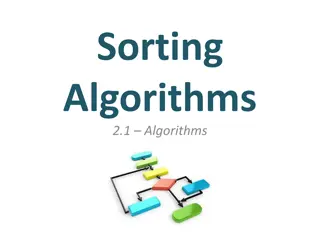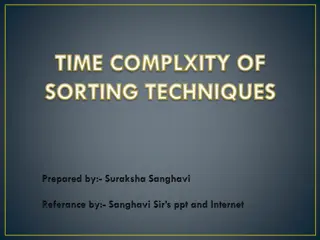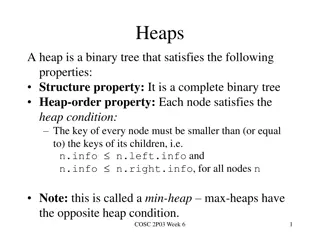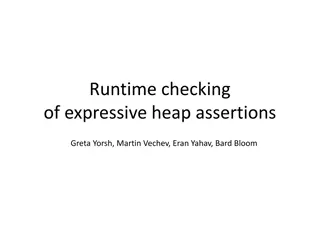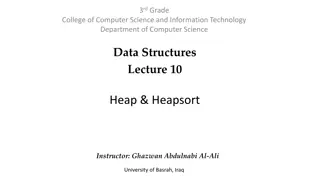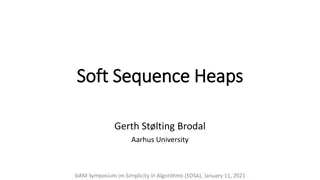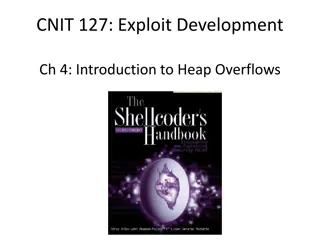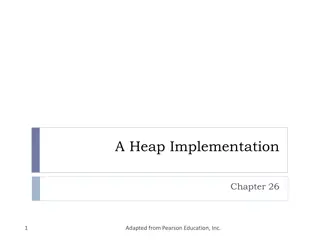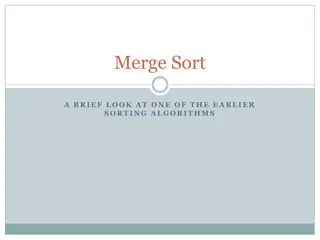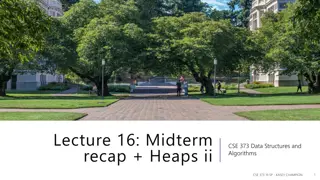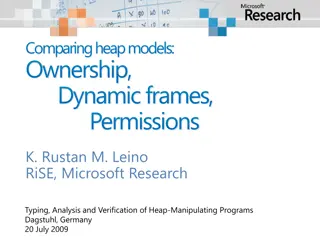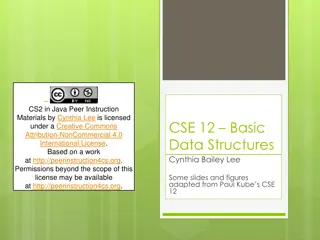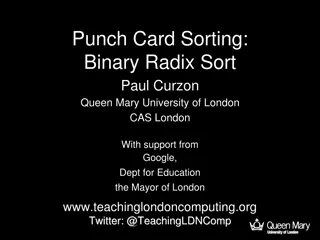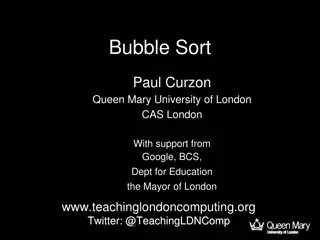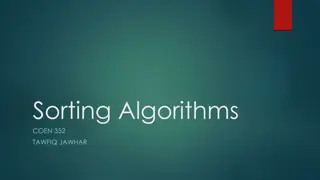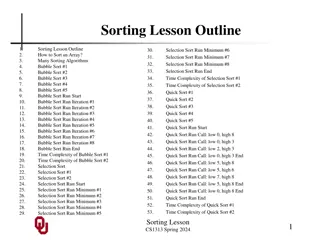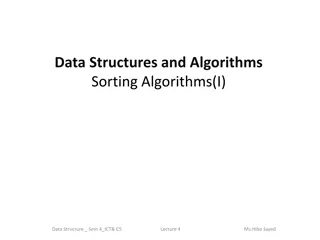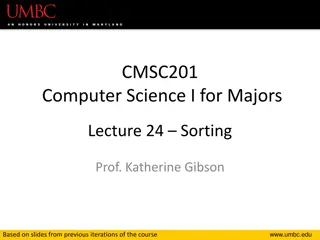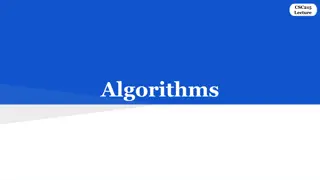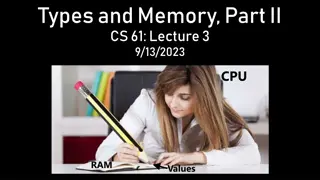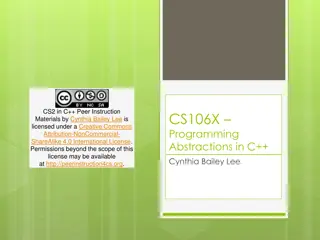Searching & Sorting Algorithms Overview
Explore various sorting and searching algorithms such as Linear Search, Binary Search, Bubble Sort, Selection Sort, and Insertion Sort. The provided content presents code snippets and explanations for each algorithm, illustrating their implementation in both C++ and generic pseudocode.
0 views • 10 slides
Understanding Sorting Algorithms: Bubble Sort and Insertion Sort
Master the concepts of standard sorting algorithms through a detailed exploration of Bubble Sort and Insertion Sort. Learn how each algorithm functions step-by-step, gaining a practical understanding of sorting techniques in computational thinking and programming. Engage in hands-on activities to ap
1 views • 14 slides
Understanding Memory Management in Computer Systems
Explore Carnegie Mellon University's concepts on heap management and memory allocation strategies as detailed in "Computer Systems: A Programmer's Perspective." Dive into topics such as extending the heap, free blocks, and common problems with throughput and memory utilization.
0 views • 21 slides
Sorting Techniques: Complexity, Stability, and Cases
This content discusses various sorting techniques, their time complexity in worst, best, and average cases, stability, and types of sorts. It includes a comparison table listing algorithms such as Bubble Sort, Selection Sort, Insertion Sort, Quick Sort, and more, along with their respective complexi
0 views • 10 slides
Understanding Heaps in Binary Trees
Heaps are binary trees that adhere to specific properties, such as being complete and satisfying the heap-order property. This involves nodes having keys smaller than or equal to their children. Key operations like removeMin and insert can be performed on heaps efficiently. Array implementations all
0 views • 10 slides
Runtime Checking of Expressive Heap Assertions
Motivated by the unreliability of large software systems due to concurrency bugs and limitations of static analysis, the goal is to enable runtime analysis of deep semantic properties with low overhead. This involves checking expressive heap assertions at runtime with minimal impact on performance,
0 views • 15 slides
Data Structures and Heaps in Computer Science - Lecture 10 Overview
Explore the concept of heaps and heapsort in data structures, focusing on the binary heap data structure as an array object that resembles a nearly complete binary tree. Learn about binary tree representations, heap properties, and vertex assignments in a linear array to enhance search efficiency. U
1 views • 33 slides
Soft Heap and Soft Sequence Heaps: Properties and Applications
Explore the properties and applications of Soft Heap and Soft Sequence Heaps, discussing how corruption handling and selection functions are optimized in these data structures. The concept of car-pooling and the simplification of heap operations are highlighted, along with references to relevant res
1 views • 10 slides
Overview of Soft Sequence Heaps in Algorithms
Soft sequence heaps are a specialized data structure designed to handle corruptions in heap operations efficiently. This technology, introduced at Aarhus University, simplifies heap manipulation, particularly in car-pooling and other applications, with a focus on minimizing corruptions during extrac
0 views • 10 slides
Understanding Heap Sort in Data Structures
Heap Sort, a sorting algorithm based on the concept of a heap data structure, is explained in detail. The properties of a heap, its implementation using a complete binary tree, and its application in priority queues are discussed. The process of building a heap, inserting elements, and sorting them
0 views • 7 slides
Understanding Heap Overflows: An Introduction to Exploit Development
Learn about heap overflows in exploit development, including heap structure, memory maps, exploiting vulnerabilities, and controlling writes in the heap. Understand the difference between stack and heap, viewing heap in gdb, targeted exploit techniques, and the challenges of controlling EIP in the h
0 views • 17 slides
Understanding Priority Queues and Heap Data Structures
Priority queues play a key role in computer science algorithms by managing data based on priority levels. The use of heap data structures enhances the efficiency of priority queue operations. This tutorial covers the basics of priority queues, their applications, different implementations such as li
0 views • 30 slides
Abstract Domains for Lists and Heap Structures: A Comprehensive Overview
Explore the concepts of quantified data automata on skinny trees, automatic shapes in static analysis, universally quantified properties on lists, heap configurations with skinny trees, and the extension of quantified data automata over lists. Dive into the abstract domain of automata to capture inf
1 views • 20 slides
Heapsort and Heaps: A Generic Algorithm for Sorting
This content discusses the concept of heapsort and heaps in the context of sorting algorithms. It covers a generic algorithm for sorting a sequence of numbers in non-decreasing order, detailing different implementations and time requirements for inserting and removing elements from a set. A clever c
0 views • 50 slides
Understanding Heap Data Structure Implementation
Explore the implementation of a heap data structure through a complete binary tree concept, array representation, adding elements, removing elements, and avoiding swaps. Learn the steps involved in adding, removing, and organizing elements within a heap for efficient data storage and retrieval.
0 views • 17 slides
Understanding Heap Sort and Binary Search Tree Concepts
Learn about Heap Sort for sorting elements in ascending or descending order, Priority Queue as a data structure supporting key operations, Binary Trees with recursive definitions, and exercises involving priority queue operations. Explore the concepts through visual aids and examples provided in the
0 views • 18 slides
Understanding Merge Sort Algorithm in Computer Science
Explore the concept of the merge sort algorithm as a practical example of tree recursion. Learn how merging works, the steps involved in the merge algorithm, and how recursive merge sort can efficiently sort unsorted lists. Dive into the recursive implementation of merge sort and grasp its recursive
0 views • 22 slides
Understanding Merge Sort: A Brief Overview of an Earlier Sorting Algorithm
History of the Merge Sort, its principles of divide and conquer, and visual representations of how the algorithm works through comparisons and sorting steps. Includes a hands-on example of applying Merge Sort to reorder a list of months.
0 views • 23 slides
Understanding Heap Overflow Attacks
A heap is a collection of variable-size memory chunks managed by the program. Heap overflow attacks occur when malicious actors corrupt heap memory, potentially allowing them to overwrite data and execute arbitrary code. This poses a significant security risk. The process involves manipulating heap
2 views • 19 slides
Implementing Heaps: Node Operations and Runtime Analysis
Understanding the implementation of heaps involves knowing various node operations like finding the minimum node, last node, next open space, children, and parent. The runtime analysis of heap operations such as peekMin, removeMin, and insert are crucial for optimizing performance. This recap covers
0 views • 9 slides
Understanding Priority Queues and Heaps in CSE 373 Lecture
Today's lecture in CSE 373 covers the Priority Queue Abstract Data Type (ADT), the properties of heaps, and their implementations. Key topics include the completeness property of heaps, different priority queue implementations such as the binary search tree for faster insert and find operations, and
0 views • 21 slides
A Comparative Analysis of Heap Specification Approaches
This presentation discusses various approaches to heap specification, including ownership systems, dynamic frames, permissions, and capabilities. It explores challenges related to invariants and frames, showcasing examples from RockBand and Object state specifications. The discussion covers tools li
0 views • 11 slides
Understanding Memory Management Tradeoffs in Web Browsers
Explore the tradeoffs between memory usage, CPU cost, and performance in web browsers. Learn about setting heap limits, Pareto optimality, and compositional heap limit rules to optimize memory usage efficiently.
1 views • 18 slides
Binary Trees and Heap Implementation in Java
Explore the concepts of binary trees, heap implementation, and traversal techniques in Java through engaging peer instruction materials by Cynthia Lee. Learn about heap uniqueness, in-place heapsort, and generic binary trees. Test your knowledge with reading quizzes and analyze heap outcomes based o
0 views • 27 slides
Overview of SB 850 Homeless Emergency Aid Program (HEAP)
SB 850 establishes the Homeless Emergency Aid Program (HEAP) to provide flexible block grant funds to address immediate homelessness challenges in California. The program moves the Homeless Coordinating and Financing Council (HCFC) to the BCSH Agency and designates the BCSH Secretary as the HCFC Cha
0 views • 33 slides
Dynamic Memory Management Overview
Understanding dynamic memory management is crucial in programming to efficiently allocate and deallocate memory during runtime. The memory is divided into the stack and the heap, each serving specific purposes in storing local and dynamic data. Dynamic memory allocators organize the heap for efficie
0 views • 31 slides
Understanding Memory Management in C Programming
The discussion covers various aspects of memory management in C programming, including common memory problems and examples. It delves into memory regions, stack and heap management, and static data. The examples illustrate concepts like static storage, heap allocation, and common pitfalls to avoid.
0 views • 24 slides
Understanding Binary Radix Sort for Efficient Data Sorting
Explore the concept of Binary Radix Sort explained through sorting punch cards into order with a pencil. Learn how to efficiently sort data using divide and conquer techniques based on binary numbers. Discover the practical ways to teach computing and computational thinking without relying on comput
0 views • 13 slides
Divide and Conquer Algorithms - Dr. Maram Bani Younes
This chapter on divide and conquer algorithms introduces key concepts such as dividing the problem into smaller subproblems, solving them, and combining the solutions. It covers techniques like finding maximum and minimum elements, maximum contiguous subsequence sum, binary search, quick sort, merge
1 views • 30 slides
Exploring Bubble Sort Algorithm for Teaching Computing Concepts
Dive into the world of sort algorithms with a focus on bubble sort, its efficiency, and computational thinking. Discover practical ways to teach computing concepts in a fun and engaging manner. Explore the process of bubble sort, learn how to compare and swap array elements, and understand the impor
0 views • 19 slides
Understanding Bubble Sort Algorithm - COEN 352 by Tawfiq Jawhar
Dive into the world of sorting algorithms with a focus on Bubble Sort. Explore how Bubble Sort works through animations, visual representations, and explanations of its time complexity, stability, and in-place nature. Discover the significance of one iteration in Bubble Sort and how it affects the a
0 views • 17 slides
Introduction to Algorithms and Sorting Techniques
Brute force and exhaustive search are fundamental problem-solving approaches in algorithm design, while selection sort and bubble sort are common sorting techniques. Brute force involves solving problems directly based on the problem statement, with the computer carrying out the computations. Select
0 views • 18 slides
Overview of Sorting Algorithms
Explore the world of sorting algorithms through a detailed lesson outline covering popular methods like Bubble Sort, Selection Sort, and Quick Sort. Learn how to sort an array, understand the time complexity of different sorting techniques, and discover the intricacies of implementation through code
0 views • 53 slides
Introduction to Bubble Sort Algorithm
Bubble sort is a simple comparison-based sorting algorithm that repeatedly compares adjacent elements and swaps them if they are in the wrong order. It is easy to implement but inefficient for large datasets. The algorithm iterates through the list multiple times until no more swaps are needed, ensu
0 views • 16 slides
Understanding Sorting Algorithms in Computer Science
Delve into the world of sorting algorithms in computer science with a focus on Selection Sort, Bubble Sort, Quick Sort, and Radix Sort. Learn how sorting impacts the efficiency of other algorithms and explore the scalability of different sorting methods. Discover the importance of sorting algorithms
0 views • 37 slides
Overview of Sorting Algorithms and Quadratic Sorting - CS 330 Lecture Notes
Sorting algorithms play a crucial role in computer science and computing tasks, consuming a significant portion of computing power. Various algorithms such as Bubble Sort, Selection Sort, and Insertion Sort are discussed for sorting a list of values efficiently. Quadratic sorting algorithms like Sel
0 views • 30 slides
CSE 545 Heap Challenges Overview
In CSE 545, students can expect a series of challenges related to heap exploitation techniques. The assignments involve releasing new challenges with specific deadlines and combining the points earned from previous challenges. The grading system is structured to allocate percentages to each assignme
0 views • 32 slides
Introduction to Basic Algorithms: Searching and Sorting
Explore the fundamentals of basic algorithms focusing on searching and sorting techniques. Learn about linear (sequential) search, sorting problem complexities, and popular algorithms like Bubble Sort and Selection Sort. Discover the key concepts, terms, and functions involved in search and sort alg
0 views • 15 slides
Understanding CPU and RAM Relationship in Memory Segments
A program's address space consists of four segments - code, static data, stack, and heap. Each segment plays a crucial role in memory allocation and management. The OS and C++ runtime handle the allocation and deallocation of memory in the heap segment. Garbage collectors in certain languages aid in
0 views • 22 slides
Understanding Recursion and Sorting Algorithms in C++ Peer Instruction Materials
Explore the Traveling Salesman Problem, recursive sorting techniques like Merge Sort and Quick Sort, and the challenges of mapping algorithms versus human perception. Delve into the importance of Selection Sort and scenarios of worst vs. best cases in algorithms.
0 views • 23 slides

